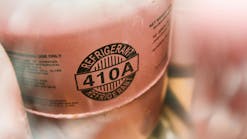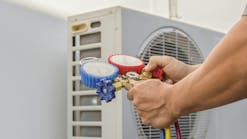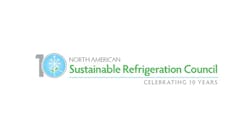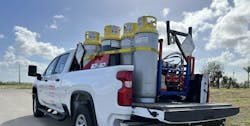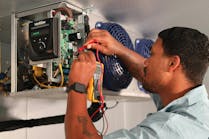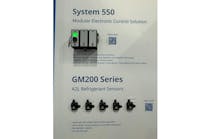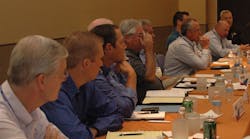Latest from Refrigeration
Rulings by the Environmental Protection Agency (EPA) related to refrigerants are causing ripple effects around the HVACR world. At no other time in the industry’s history has there been so much activity, concern and chatter related the phaseout of some of HVACR contractors’ favorite gasses.
And for good reason. Refrigerant is the “lifeblood” of an HVAC or supermarket system. Without it, you’re looking at just a hunk of metal on a rooftop, in the backyard of a home or in a supermarket mechanical room.
I recently attended two events in which alternative refrigerants and alternative refrigeration systems for stores and other medium temperature uses were the main topics: the latest Danfoss Symposium — “Refrigerants2Sustainability” — and Emerson Climate Technology’s new “E360 Forum.”
First, I’d like to thank Danfoss and Emerson for the leadership role they’ve assumed in providing as much information as possible to OEMs, contractors and distributors regarding refrigerant phaseouts and alternatives. Both of these free events required significant time and cost that was absorbed by those two companies.
The Danfoss Symposium — hosted admirably by Danfoss North America President John Galyen and Lisa Tryson, director of communications and PR — combined legislative updates by the EPA and product solutions by select manufacturers. More than 40 persons attended, representing manufacturers, contracting firms, supermarkets and energy agencies.
Drusilla Hufford, director of the EPA Stratospheric Protection Division, provided an update on the current phaseout schedule, especially news related to the EPA’s July “proposed rule” that took many people by surprise. That rule would remove R507A and R404A as refrigerant options by January 2016. Others were included, but those are the two most common gasses. This action is part of an accelerated plan by the Obama administration to reduce greenhouse gas emissions at a greater pace. See bit.ly/whmeeting.
Hydrocarbons are here. The notable alternatives to industry’s favorite refrigerants include propane (R290) and carbon dioxide (CO2), for use in both residential refrigerators and commercial systems.
Hydrocarbons are here. The notable alternatives to industry’s favorite refrigerants include propane (R290) and carbon dioxide (CO2), for use in both residential refrigerators and commercial systems. Thankfully, manufacturers have been at work perfecting systems to use both of those gasses.
During the Danfoss Symposium, held in Washington, DC, Tim Anderson, principal engineer with Hussman Corp., and Charles Hon, engineering manager for True Manufacturing — presented case studies.
Anderson described how propane was now being used in a micro-distributed system at an H.E. B. market, with good results. The system uses 150 grams of propane per “circuit” or self-contained unit.
Charles Hon said newer hydrocarbon (HC) technologies are seeing 6-12% improvements in energy efficiency over R134A, and 20% more than R404A. True has developed a narrow depth store refrigerator that is indeed 22% more energy efficient with a propane refrigerant charge of 85g.
And host company Danfoss has also been busy with R&D, with a new Danfoss System Manager, Turbocor compressor and VLT AQUA Drive as examples.
The Emerson “360 Forum” is a new series of roadshows that will provide information on issues and trends to refrigeration contractors and distributors regarding refrigerant phaseouts and alternative systems.
During the inaugural Forum in Columbus, OH, Rajan Rajendran presented an update on the ever-changing regulatory picture, and the implications regulations have on foodservice and food retail.
“If you work with refrigerated, reach-in and walk-in cases and think the EPA’s Significant New Alternatives Policy (SNAP) proposed changes will not impact you, think again,” Rajendran said, referring to the proposed early 2016 delisting of R404A and R507A. Rajendran gave a thorough presentation on likely alternatives and their properties.
Mitch Knapke, director of food retail marketing and André Patenaude, director of CO2 business development, provided information on new Emerson CO2 systems that will help accomplish the goals of reduced refrigerant charge, lower global warming potential, and improved energy efficiency. Emerson’s new transcritical CO2 booster uses CO2 (R744) as a direct refrigerant in medium temp and low temp applications.
John Wallace, Emerson’s director of innovation, retail solutions, covered how to effectively use energy management systems to save energy and maintenance costs. He described areas that don’t require a lot of cost or extra effort to achieve this savings. Then, he described how to use the data that the systems, such as Emerson’s Einstein, provide to help contractors analyze system performance.
Danfoss, Emerson, and other manufacturers are doing what needs to be done to help contractors and distributors stay in the ‘loop’ on refrigerant changes. If you’re in the dark about what these changes might mean to your business, consulting with a representative from either of these companies would be a good idea.

